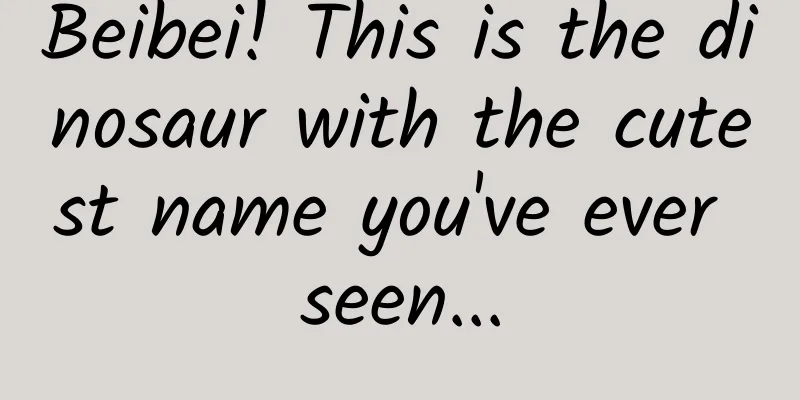Beibei! This is the dinosaur with the cutest name you've ever seen...

|
In 1993, accompanied by rumbling thunder, bean-sized raindrops fell on a hillside in Zhaoying Village, Yangcheng Township, Xixia County, Henan Province. The rain washed away the ochre-red soil, revealing gray-black rock fragments beneath the soil. Looking around, the hilltop was covered with these fragments, and they all had a common identity - dinosaur eggs from the late Cretaceous period 90 million years ago. After many unfortunate experiences, he finally returned to his hometown Under the shadow of the dark clouds, three or two villagers were cleaning with simple tools and wrapping the dinosaur eggs in cloth bags. At that time, fossil smuggling was rampant, and good-quality dinosaur eggs could often be sold at a high price. Some villagers took the risk and sold these important fossil resources abroad through the black market. Over the past decade, hundreds of dinosaur egg fossils have been lost overseas. Years of experience in stealing rocks have given these robbers some experience. After comparing with previous fossils, they soon realized that this discovery was unusual: five dinosaur eggs were neatly arranged in a large nest with a diameter of nearly 3 meters. Although the eggshells were broken, the outlines were still clearly discernible. The nest of eggs of Beibeisaurus sinensis | Hanyong Pu et al. / Nature (2017) What's even more surprising is that a baby dinosaur was curled up in one of the eggs, and its off-white bones were particularly eye-catching in the gray-black eggshell. The excavators smelled the scent of wealth and quickly packaged this precious dinosaur embryo fossil together with the dragon egg and sold it. When the baby dinosaur next appeared, it was in the United States across the ocean. In the fossil market, this unique dinosaur egg and dinosaur embryo immediately attracted everyone's attention, including Louie Psihoyos, the royal photographer of the National Geographic magazine (who later directed and filmed the world-famous documentary "The Cove"). Louie fell in love with the cute baby dinosaur at first sight and nicknamed it "Baby Louie". He took many photos of the baby and told his colleagues at National Geographic about the discovery. National Geographic took it very seriously and even asked artist Brian Cooley to make a scale model and used the model's photo as the cover of its May 1996 issue. Reconstruction of a Beibeisaurus sinensis embryo | Vladimir Rimbala / Wikipedia As soon as the news came out, American paleontologists immediately began to study "Baby Louie". While scientists were busy studying the fossil, fossil dealers did not stop making profits. In 2001, the fossil agent of "Baby Louie" found a buyer, and the fossil was purchased by the Children's Museum of Indianapolis, USA, and was officially exhibited in the museum after being repaired. China lodged a strong protest and made representations to the museum for the stolen fossils being exhibited abroad. After much consultation and negotiation, the museum agreed to return the "Baby Louis" fossil. It was not until 2013 that "Baby Louis" was returned to China and settled in the Henan Provincial Geological Museum, returning to its hometown after being away for nearly 20 years. Eggs of Beibeisaurus sinensis, now in the Henan Geological Museum | Gary Todd / Wikimedia Commons Dragon eggs are so big that they can’t be fried in one pan What is the largest egg on earth? Perhaps someone would answer the ostrich egg. The average ostrich egg is 15 cm long and 13 cm wide, 20 times the volume of an ordinary chicken egg, and is indeed the well-deserved "world's largest egg" among existing species. Ostrich eggs are not as large as the extinct elephant bird eggs. It is estimated that the largest elephant bird egg is 35.1 cm long and 25.9 cm wide, the size of a basketball. Compared with the dinosaur egg in which "Baby Louie" lived, the elephant bird egg is dwarfed by the big one. The dinosaur egg of "Baby Louie" is long and oval, up to 45 cm long, nearly twice the size of a rugby ball. Surprisingly, the egg of "Baby Louie" is not the largest dinosaur egg. In 2007, Chinese scientists discovered another dinosaur egg in Xixia, which is 61 cm long and 17.9 cm wide. It is a real giant egg. The "Baby Louie" dinosaur egg and this giant egg both belong to the Xixia giant long egg Macroelongatoolithus xiaensis in the genus Macroelongatoolithus. This genus of dinosaur eggs has been found in many places in North America and East Asia. In my country, it is mainly concentrated in Tiantai, Zhejiang, Xixia and Lingbao, Henan, and is famous for its large size. Eggs of Troodon formosus, found in Western Montana, USA | James St. John / Flickr Author's Tips There are often no adult dinosaur fossils found around dinosaur eggs, and it is often difficult to identify which dinosaur laid the eggs. To avoid confusion, paleontologists classify dinosaur eggs as independent egg genera and species. For example, the giant elongated egg genus mentioned above is a dinosaur egg genus. This classification method was proposed by Chinese paleontologist Mr. Zhao Zikui in 1975, so Mr. Zhao is also known as the "first person in Chinese dinosaur egg research." Big guy from a prominent family What kind of dinosaur is Baby Louie? Since its discovery, scientists have been trying to solve the mystery of its identity. Judging from the structural characteristics of Baby Louie, it should be a member of theropod dinosaurs, but which species of theropod dinosaur is it? Scholars are at a loss. Some people believe that "Baby Louie" is a baby of a therizinosaur, because its claws are long and sharp, similar to those of therizinosaurs. Moreover, therizinosaurs are not short of huge members, so it is reasonable for them to lay such a huge egg. Some people also said that the structural features of "Baby Louie" are very similar to those of Oviraptorosaurs, and it is more likely to be an Oviraptorosaur cub. Soon someone jumped out to oppose this speculation: the Oviraptorosaurs discovered at that time were very small, the largest was only a little over 2 meters long, and without the tail, it was about the size of a goose. A dinosaur the size of a goose laid eggs larger than a football? Supporters of the Oviraptorosaur theory were mercilessly ridiculed. Therizinosaurus with strange "nail art" | Jaime Headden & Matt Martyniuk / Wikimedia Commons However, in 2007, a major discovery from Inner Mongolia, my country, slapped the mockers in the face. A research team led by Xu Xing, a famous Chinese paleontologist, discovered the fossil of a giant oviraptor dinosaur, Gigantoraptor, in the Erenhot Basin. It is estimated that Gigantoraptor was 7 to 8 meters long and weighed about 1 to 3 tons, making it the largest oviraptor dinosaur in history. Now it was the turn of the mockers to fight back: Look, such a big dragon lays such a big egg, is it a beaver? This is very beaver. Gigantoraptor, too big to fit in a pot (no) | Dinoguy2 / Wikimedia Commons In 2007, "Baby Louie", which had been unearthed for 21 years, finally got its own ID card: Beibeilong sinensis. Although this name is cute and childish, the confirmation of "Baby Louie"'s identity includes many elements such as fossil theft, overseas fame, and transnational cooperation, which is comparable to a Sino-US co-produced TV series. Beibeisaurus fossil skeleton | Hanyong Pu et al. / Nature (2017) With the joint efforts of experts from China, the United States and Canada, "Baby Louie" was eventually identified as a member of the family Anchignathidae of the order Oviraptorosaurs, a relative of the same family as Gigantopithecus, but more primitive than Gigantopithecus. Because only embryonic fossils have been found, no one knows how big an adult Chinese Baby Dragon could grow. Based on the size of Gigantopithecus, some experts estimate that Baby Dragon could grow to 7.6 meters, which is taller than a floor when standing upright. There are still many things to explore about "Louie Baby": How did it die? Where are its parents? Do its parents take care of it? What does it like to eat? Does it have feathers... Don't worry, it took us 20 years to figure out the identity of "Louie Baby", so let's unveil its mystery bit by bit. I believe time will tell us the answer. |
<<: This year's Nobel Prize in Chemistry is finally not a science award!
Recommend
Activity operation: JD.com Double 11 "Collect Cards and Earn Jingdou" Activity Full Analysis
As an unserious soul writer, this time I will wri...
Zhihu promotion operation skills practical strategy
As one of the mainstream new media platforms, Zhi...
ASO Optimization: How to write a good APP description introduction?
APP description has a great impact on the current...
The top ten screen-sweeping crises in 2019!
Crisis public relations summaries are made every ...
B Station Brand Marketing Guide!
Among the many New Year’s Eve parties in 2019, Bi...
How to promote with limited account budget?
How should a search promotion account with a smal...
Mobile browsers: Google is about to take on Apple
Data from market research firm Net Applications sh...
FAO: Climate Change Strategy 2022-2031
The Climate Change Strategy, approved by the FAO ...
Douyin Enterprise Account Operation Methodology
1. Four major manifestations of "no goods in...
Comments on 10 of the most popular domestic open source projects on Github
[[126688]] The quality of an open source product ...
iPhone 12 price trend: 10% drop in 2 months, 18% drop in 5 months
iPhone 12, Pro, and Pro Max price trends over the...
How to master social e-commerce and acquire customers at low cost?
This article is the first in a series of detailed...
The future of autonomous driving has arrived. The era of unmanned taxis and trucks will begin as early as 2020
Autonomous driving is not something that is out o...
Real shots of Kia's new e-generation Forte at the Guangzhou Auto Show: Will the concept-driven Korean cars be accepted by the market?
As the international situation changes suddenly, ...
Android GO system is developing slowly: only a dozen apps are available
At the Google I/O conference in 2017, Google anno...









